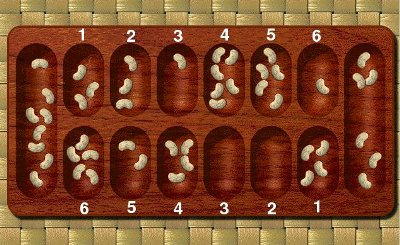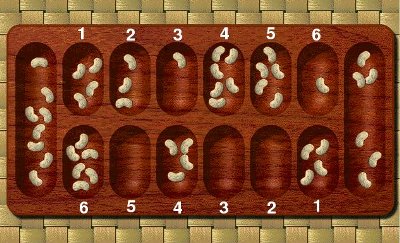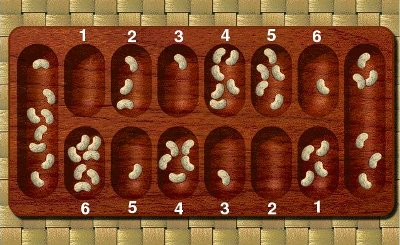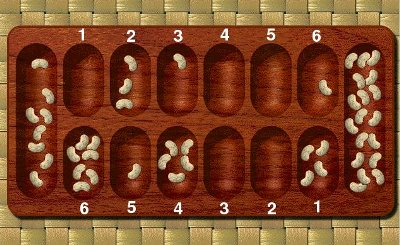
by John P. Pratt
Sat 19 Sep 2009
Basic rules for all variations.
 |
1. The game usually begins with six seeds in each pit. A player may only begin a move from a pit that has at least two seeds. That is, pits with only one seed can never be played.
 |
3. After the seeds are sown, if the last seed fell into a pit on either side of the board that already contained seeds, then all of the seeds are taken from that pit and sown again in the same manner, but in the opposite direction. If that final pit was not empty, then all of those seeds are removed and sown again in reverse direction. This multi-lap play continues until the last seed falls into an empty pit. That ends the turn. Figure 3 shows the board after this continuing move, being counterclockwise from the Upper Player's Pit 1.
 |
Figure 4 shows the board after all of the captured seeds are put in the Lower Player's capture pit. All of the seeds in the Upper Pit 4 were captured because the final seed sown was into an empty pit opposite them. But the seeds in Upper Pit 5 were also captured because the following pit on the Lower Player's side was also empty and was immediately following it in the order of the move. If his Pit 1 were also empty, then the seeds opposite would also have been captured. But if Pit 1 was empty and Pit 2 were not, then only the seeds across from Lower Pit 3 would have been captured. If both of the Lower Pit 1 and 2 had also been empty, and the Upper Pit 5 had also been empty, then the capturing would have stopped with only those opposite Lower Pit 3. That is, no seeds would have been captured from the Upper Pit 5 or 6.
 |
5. A player who begins his turn with no legal move (remember pits with single seeds cannot be played), passes his turn and waits until he has a legal move. When neither side has a legal move then each player adds any single seeds left to his capture pit.
I have seen rules given where the player's capture pit is included in sowing. In that case, if the final seed falls into the capture pit, the player's turn ends, rather than winning an extra turn as in Mancala. Allowing an extra turn gives too much advantage to the player. In some ways this might be a superior variation because it gets the game moving faster.